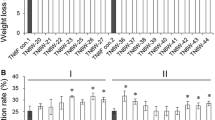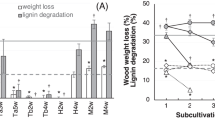Abstract
White-rot basidiomycetes are the main decomposers of woody biomass in forest ecosystems. Little is known, however, about the interactions between white-rot fungi and other microorganisms in decayed wood. A wood-rotting fungus, Stereum sp. strain TN4F, was isolated from a fruit body, and its coexisting cultivable bacteria were isolated from its substrate; natural white-rot decayed wood. The effects of bacteria on fungal growth were examined by confrontational assay in vitro. A growth-promoting bacterium for this Stereum strain was identified as Curtobacterium sp. TN4W-19, using 16SrRNA sequencing. A confrontational assay revealed that Curtobacterium sp. TN4W-19 significantly promoted the mycelial growth of Stereum sp. TN4F in the direction of the bacterial colony, without direct contact between the mycelium and bacterial cells. This is the first report of a positive interaction between a white-rot fungus and a coexisting bacterial strain in vitro.



Similar content being viewed by others
References
Bending GD, Poole EJ, Whipps JM, Read DJ (2002) Characterisation of bacteria from Pinus sylvestris-Suillus luteus mycorrhizas and their effects on root–fungus interactions and plant growth. FEMS Microbiol Ecol 39:219–227
Blanchette RA, Shaw CG (1978) Associations among bacteria, yeasts, and basidiomycetes during wood decay. Phytopathology 68:631–637
Boddy L (2000) Interspecific combative interaction between wood-decaying basidiomycetes. FEMS Microbiol Ecol 31:185–194
Cespedes R, Salas L, Calderon I, Gonzales B, Vicuna R (1992) Microbial and biochemical-characterization of a bacterial consortium isolated from decaying wood by growth on a β-O-4 lignin-related dimeric compound. Arch Microbiol 158:162–170
Clausen CA (1996) Bacterial association with decaying wood: a review. Int Biodeterior Biodegrad 37:101–107
Deveau A, Brulé C, Palin B, Champmartin D, Rubini P, Garbaye J, Sarniguet A, Frey-Klett P (2010) Role of fungal trehalose and bacterial thiamine in the improved survival and growth of the ectomycorrhizal fungus Laccaria bicolor S238N and the helper bacterium Pseudomonas fluorescens BBc6R8. Environ Microbiol Rep 2:560–568
Folman LB, Klein Gunnewiek PJ, Boddy L, de Boer W (2008) Impact of white-rot fungi on numbers and community composition of bacteria colonizing beech wood from forest soil. FEMS Microbiol Ecol 63:181–191
Frey-Klett P, Garbaye J, Tarkka M (2007) The mycorrhiza helper bacteria revisited. New Phytol 176:22–36
Hirai H, Kondo R, Sakai K (1994) Screening of lignin-degrading fungi and ligninolytic enzyme activities during biological breaching of kraft pulp. Mokuzai Gakkaishi 40:980–986
Hiraishi A (1992) Direct automated sequencing of 16S rDNA amplified by polymerase chain reaction from bacterial cultures without DNA purification. Lett Appl Microbiol 15:210–213
Kamei I, Suhara H, Kondo R (2005) Phylogenetical approach to isolation of white-rot fungi capable of degrading polychlorinated dibenzo-p-dioxin. Appl Microbiol Biotechnol 69:358–366
Kamei I, Sonoki S, Haraguchi K, Kondo R (2006) Fungal bioconversion of toxic polychlorinated biphenyls by white-rot fungus, Phlebia brevispora. Appl Microbiol Biotechnol 73:932–940
Kamei I, Takagi K, Kondo R (2011) Degradation of endosulfan and endosulfan sulfate by white-rot fungus Trametes hirsute. J Wood Sci 57:317–322
Kataoka R, Futai K (2009) A new mycorrhizal helper bacterium, Ralstonia species, in the ectomycorrhizal symbiosis between Pinus thunbergii and Suillus granulatus. Biol Fertil Soils 45:315–320
Kirk TK, Fenn P (1982) Formation and action of the ligninolytic system in basidiomycetes. In: Frankland JC, Hedger JN, Swift MJ (eds) Decomposer basidiomycetes: their biology and ecology. Cambridge University Press, New York, pp 67–90
Mikluscak M, Dawson-Andoh BE (2004) Microbial colonizer of freshly sawn yellow-poplar (Liriodendron tulipifera L.) lumber in two seasons: Part 2. Bacteria. Holzforschung 58:182–188
Murray AC, Woodward S (2007) Temporal change in function diversity of culturable bacteria populations in Sitka spruce stumps. For Pathol 37:217–235
Poole EJ, Bending GD, Whipps JM, Read DJ (2001) Bacteria associated with Pinus sylvestris-Lactarius rufus ectomycorrhizas and their effects on mycorrhiza formation in vitro. New Phytol 151:743–751
Purnomo AS, Mori T, Kamei I, Nishii T, Kondo R (2010) Application of mushroom waste medium from Pleurotus ostreatus for bioremediation of DDT-contaminated soil. Int Biodeterior Biodegrad 64:397–402
Riedlinger J, Schrey SD, Tarkka MT, Hampp R, Kapur M, Fiedler H-P (2006) Auxofuran, a novel metabolite that stimulates the growth of fly agaric, is produced by the mycorrhiza helper bacterium Streptomyces strain AcH 505. Appl Environ Microbiol 72:3550–3557
Saitou N, Nei M (1987) The neighbor-joining method: a new method for reconstructing phylogenetic trees. Mol Biol Evol 4:406–425
Schrey SD, Schellhammer M, Ecke M, Hampp R, Tarkka MT (2005) Mycorrhiza helper bacterium Streptomyces AcH 505 induces differential gene expression in the ectomycorrhizal fungus Amanita muscaria. New Phytol 168:205–216
Valaskova V, de Boer W, Gunnewiek PJ, Pospisek M, Baldrian P (2009) Phylogenetic composition and properties of bacteria coexisting with the fungus Hypholoma fasciculare in decaying wood. ISME J 3:1221–1281
White TJ, Bruns T, Lee S, Taylor J (1990) Amplification and direct sequencing of fungal ribosomal RNA genes for phylogenetics. In: Innis MA, Gelfand DH, Sninsky JJ, White TJ (eds) PCR protocols: a guide to methods and applications. Academic Press, San Diego, pp 315–322
Zhang HB, Yang MX, Tu R (2008) Unexpected high bacterial diversity in decaying wood of conifer as revealed by molecular method. Int Biodeterior Biodegrad 62:471–474
Acknowledgments
This study was supported in part by a Grant-in-Aid for Scientific Research from the Ministry of Education, Culture, Sports, Science and Technology of Japan (22580187 and 23688041).
Author information
Authors and Affiliations
Corresponding author
Rights and permissions
About this article
Cite this article
Kamei, I., Yoshida, T., Enami, D. et al. Coexisting Curtobacterium Bacterium Promotes Growth of White-Rot Fungus Stereum sp.. Curr Microbiol 64, 173–178 (2012). https://doi.org/10.1007/s00284-011-0050-y
Received:
Accepted:
Published:
Issue Date:
DOI: https://doi.org/10.1007/s00284-011-0050-y




